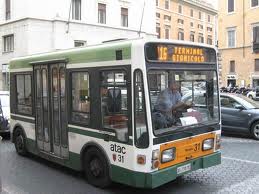The starting terminus of the South to North half of this route is actually one of the least likely places you are ever going to board it - but we might as well start at the beginning...
After several years of locating the 116's south Capolinea at the Largo dei Fiorentini, ATAC has reverted to using the Terminal Gianicolo (since the start of 2013). There remains a normal stop at the Largo, but the actual beginning and ending of the route now involves finding your way in and out of the huge bus-station - rather inconvenient in fact for foot-passengers.
The easiest way, actually, to find it is to ride the bus from the opposite direction and see where you end up...! You could try that - but since you are supposed to have confidence in this website to do the hard work for you, I will try to explain the rather tortuous directions you need to follow in order to get there.
The most obvious starting point is Piazza S Pietro. Head out of the square by the route through the columns on the left (as you face the Basilica). You emerge on the upward slope of Piazza del Santo Uffizio.
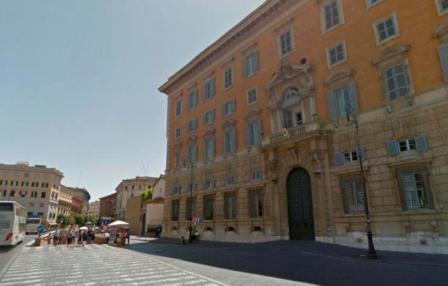
Keep following this road ahead for a hundred yards or so until you see a large stairway in the middle of the road leading down underground, signed as the way to the Terminal Gianicolo coach- and car-park. You cannot really miss this, fortunately.
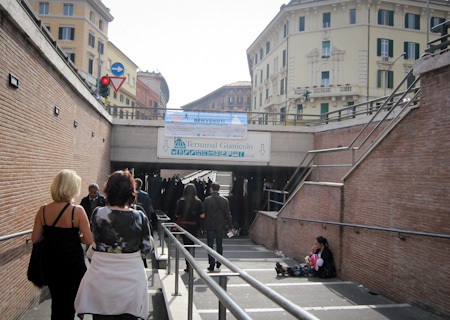
From here on, simply follow the signs (and the people!) It passes through a set of corridors, complete with moving airport-style escalators.
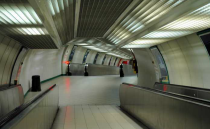
At the top of these you come through a set of swing glass doors (with a convenient vending machine close by) into the dark multi-storey coach-park, where (hopefully) a small 116 will be waiting pretty much straight in front of you...if not, there should be one along in a minute!
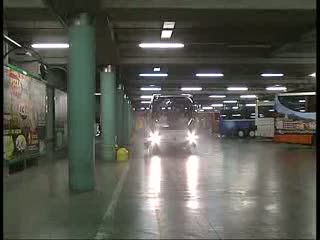
When the bus does set off, it is quite a relief when it emerges into the fresh air once more...
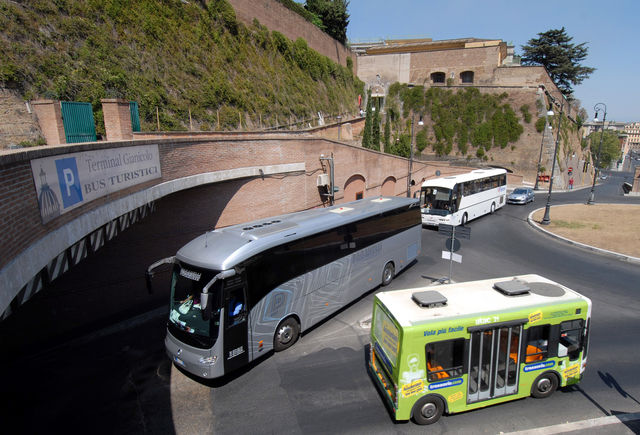
Soon it sweeps round a small roundabout before heading down the ramp to rejoin the main Lungotevere Gianicolense.
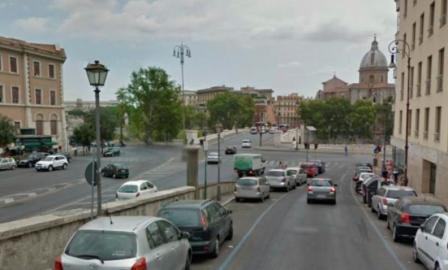
At the Piazza della Rovere, near the Porta S Spirito, is its first stop, probably where most travellers board it for the first time in this direction. It is also placed close to the Ospedale S Spirito, a functional but not very attractive building.
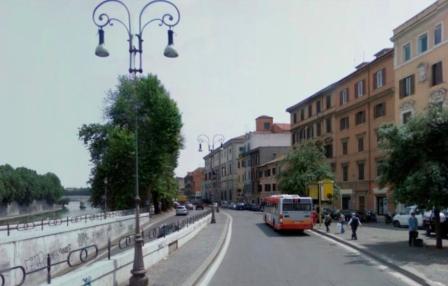
From here, the bus continues along the river (on the Trastevere side) - look behind you to the left for views of Castel Sant'Angelo.
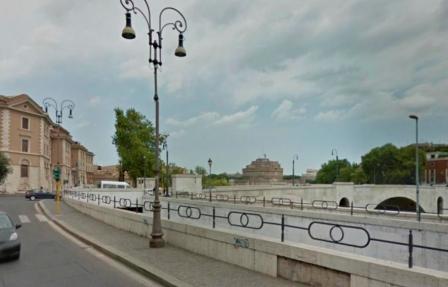
On the right, you pass the Palazzo Salviati.
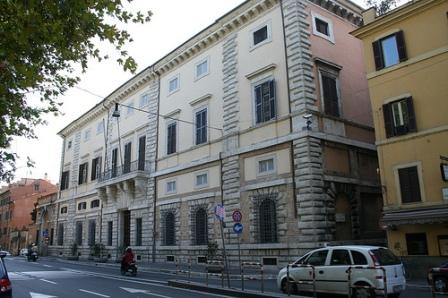
In fact, the older, narrower road Via della Lungara is still there, below the level of the modern Lungotevere: it leads back under the Porta Settimana into Trastevere past the Villa Farnesina, which once had an aspect right onto the river. Just before the bus crosses the Tiber, you may spot the little church of S Giuseppe alla Lungara on this sunken stretch, and not far past it the huge complex of the Regina Coeli prison.
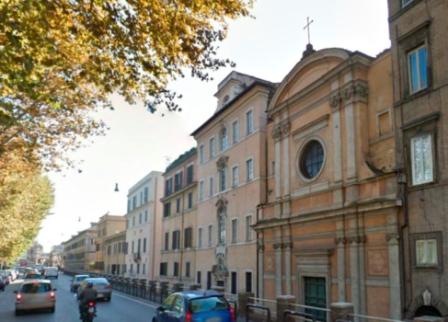
Opposite this is Ponte Mazzini, taking us over onto the streets of the southern Campus Martius. Look left and right for some fine views along the water.
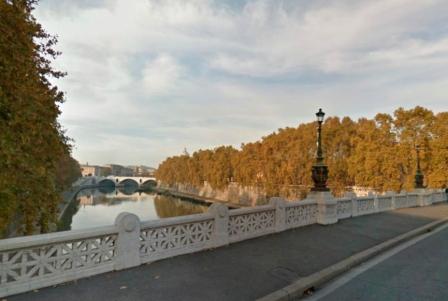
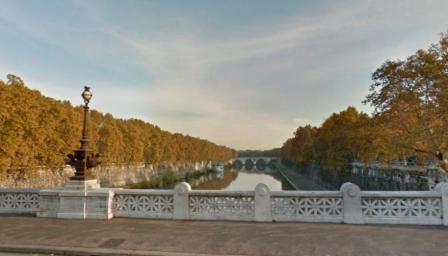
On the other side, there is a bus-stop almost at once at Piazza Perosi. The bus then travels back along the river on the Lungotevere Sangallo; to the right you can see the backs of several of the churches which stand upon (or just off) Via Giulia: we shall be passing them shortly. Firstly however the bus pulls into Largo dei Fiorentini, its previous Capolinea on this route. It may be a good moment, after this rather zig-zag journey so far, to have a look around and get your bearings again.
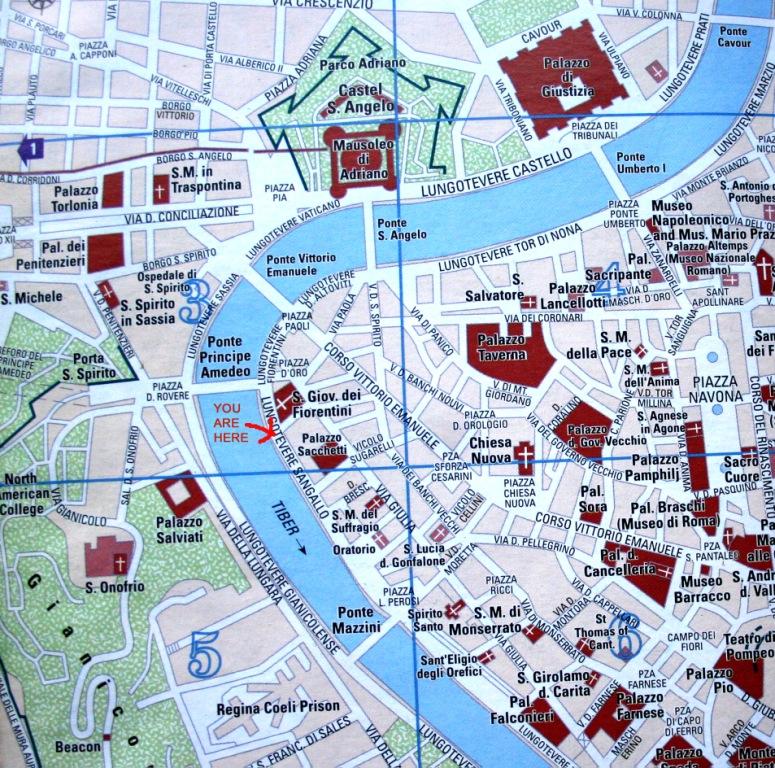
You are at one of the bends of the River Tiber, just at the south-western-most tip of the Campus Martius - Rome's army training ground in its earliest days, before public buildings began to encroach. Much of the next part of the journey will be taking you through the narrow medieval streets which were eventually built over the Roman ones. It is still one of the most attractive and atmospheric parts of modern Rome.
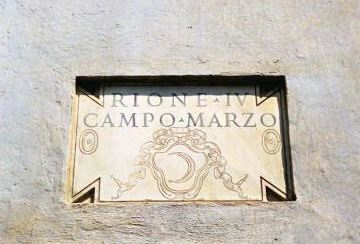
If you were to cross back by the bridge just ahead (Ponte Principe Amedeo),you would be only 5 minutes walk from the Vatican once more. Directly north of you (although you'd have to nip quickly around the sharp bend in the river to see it) is Castel Sant'Angelo, originally the burial monument or Mausoleum of the emperor Hadrian.
As the bus restarts, it turns right almost immediately into the small open square beside the church of S. Giovanni Battista dei Fiorentini, which is the representative church of Florence in Rome. Some guide books give a poor rating to this actually rather unusual and interesting building: it is definitely worth a visit - to give just one reason, it contains the tomb of Bernini's great rival architect, Borromini.
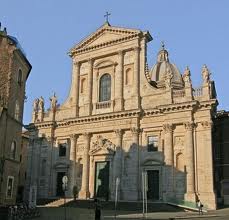
From here, the bus turns right again into Via Giulia.
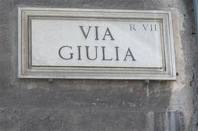
This is a beautiful, unusually long and straight road for its time: it was laid out, as its name suggests, for Pope Julius II as part of his major building programme in the early 1500's (we are around the beginning of the renaissance, in the time of artists such as Raphael). It was designed by Bramante (one of the earliest and greatest names in Italian medieval architecture) to be a 'fast-track' to St Peter's, rather than having to wind one's way through the medieval alleys. Along it, or very close off it, are a huge number of mostly neglected churches (at least 10!),as well as a prison and a Museum of Criminology, the sites of various apothecaries (some still working),and just a turn or two off to the left as you turn into the street, the lodgings and workshop of the sculptor Benvenuto Cellini.
By now you are probably approaching Via Giulia's trademark archway. Sadly shorn of its beautiful dangling creepers at the moment (I suppose they'll grow back…),this was designed by Michelangelo as part of a never-finished walkway over the Tiber to connect two palaces belonging to the Farnese family: one which you are about to see, and the other being the Villa Farnesina in Trastevere.
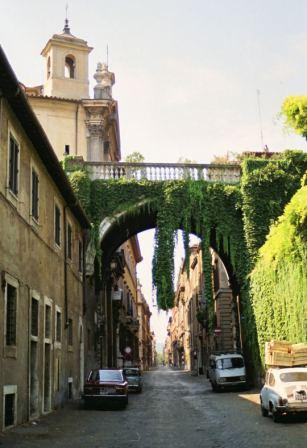
Just as the bus turns left, if you look to your right there are two interesting sights. The church of S. Maria dell'Orazione e Morte lives up to the latter half of its name with some gruesome skulls carved above the doorway, and an even more alarming plaque on the wall depicting Death himself begging for donations for plague-victims!
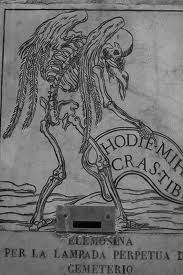
You may also just catch a glimpse of a rather grotesque wall-fountain called the 'Mascherone' - probably a Roman well-head originally. The Farnesi once had it running with wine for one of their little soirees….
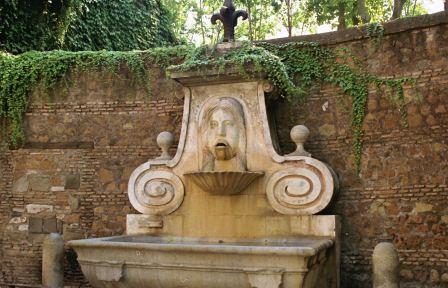
The bus now emerges from Via dei Farnesi into the Piazza also named after the family. Piazza Farnese is a lovely, calm and distinguished old square, usually quite quiet and empty. The two fountain basins on opposite sides originally came from the huge Baths of Caracalla, and were Farnesified with the addition of the family's lily symbol.
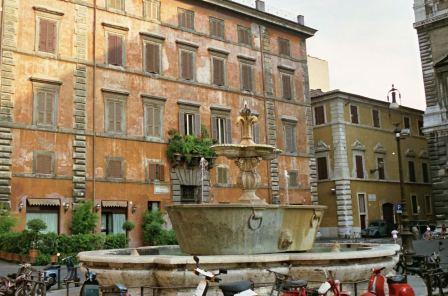
Behind you is the Palazzo itself, a dignified and beautiful building started by Sangallo and finished off by Michelangelo. Even for a massively wealthy family like the Farnesi, its construction put a considerable strain on the family coffers: work was delayed, and the Romans showed their typical barbed humour by decorating the famous 'Talking Statue' Pasquino (see 'Talking Statues') with a tin collecting-cup and a plaque hung around his neck begging for "alms for the completion of the Farnese Palace…"! Since the 1600's it has been the French Embassy, so very rarely open to visitors (2011 saw it open for some special events, so there's beginning to be more chance of getting in). If you come back at night, you can often get some tantalising glimpses through the illuminated upper windows of a set of lovely frescos by the Caracci brothers.
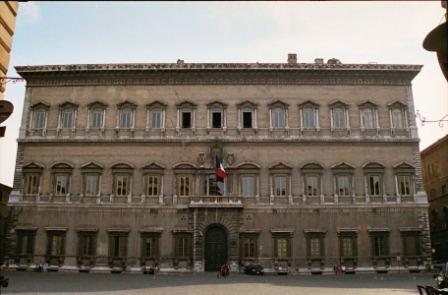
The bus leaves Piazza Farnese by the little Via dei Baullari, and almost immediately you are in another of Rome's great piazzas, which could scarcely be more of a contrast to the one you have just left. The 'Campo de' Fiori' ('Field of Flowers') is one of Rome's liveliest open squares, home to a bustling morning food-market, still used daily by the nearby residents; at night it becomes the meeting-place for everyone from seasoned old locals to tourists from all over the world and especially nowadays the younger student population (both native and otherwise).
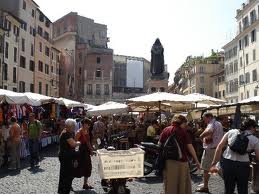
There are many cafes and restaurants all around its sides, of which one of the best known is 'La Carbonara'. At its far right side (as you cross) is a building of several mis-matched and uneven storeys, which is currently a cinema, was once a theatre, and actually stands on top of what in ancient Roman times marked the edge of another famous theatre built by Pompey the Great: part of a massive complex of public and official buildings, including the temporary meeting place of the Senate which was the site of Julius Caesar's assassination in 44BC (not, as many people assume, at the official "Senate-House" in the Roman Forum - see 'Talking Statues').
Glowering over the whole piazza is a dark, cowled statue of the very strange medieval mystic and free-thinker Giordano Bruno: his monument stands on the spot where he was burnt at the stake for heresy by the Inquisition in 1600. One wonders what he makes of the would-be Italian pop-idols nightly strumming their guitars underneath him…although I suspect he might have approved of the abysmal Indian conjuror who makes his way around the dinner tables performing his tricks (I won't spoil the 'surprise' of his big finale!).
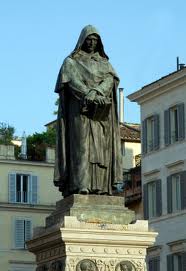
If you are in the mood for a little refreshment, hop off the bus just after it now turns left, following a one-way system, into Piazza della Cancelleria - don't worry, there'll be another one along every 10 minutes or so….
There are various decent enough places to try around here, particularly in Via Baullari, the connecting street between Piazza Farnese and the main-road Corso Vittorio Emanuele II. Back towards the Farnese Palace there is the Caffe Farnese at the corner, and next to it, an excellent traditional family-run trattoria called Hostaria Farnese (highly recommended for good Roman cooking - and great pizzas!).
The restaurants and cafes around the edge of the Campo itself are much-of-a-muchness, catering for their many visitors as almost any place would in such a popular area.
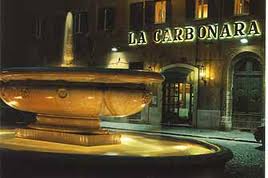
Apart from La Carbonara (which gets mixed reviews these days - I haven't tried it for many years) there is a lovely bakery one side of it, and another above-average restaurant on the other behind the fountain (R J Numb's 'Campo dei Fiori' - nice food, but also a bit above-average pricewise). There is an unusual, rather trendy take-away sandwich/pizza bar just opposite it.
The next stretch of Via dei Baullari has two 'Blue Ice' Gelato parlours within 15 metres of each other - one of the better commercial 'chains'. On the other side of the road is one of my favourite bars in the whole city, a tiny place called 'Bar Farnese' run by a lovely old Roman papa (and sometimes mama deputising…); he is unfailingly delighted to see everyone, and grateful for their custom - a proper family bar. Buy a coffee (cheaper than most) or a beer and see how many thousand thanks you get! Further down is another bakery selling all sorts of tempting pastries as well as daily bread for the locals.
Before you get back on the next bus, you could spare a moment to look through the entrance of the majestic Palazzo della Cancelleria (at the far side of the piazza from the bus-stop) and admire the courtyard (possibly by Bramante),built with a double-storey of antique columns. Although you can't get any further inside (it belongs to the Vatican),many people consider it one of Rome's most beautiful palaces.
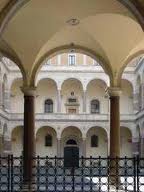
Back on the bus, you now pass the Palazzo on your left as you turn out right, into the unpleasant but unavoidable main artery known as Corso Vittorio Emanuele II (please don't ask why Rome's (well, Italy's) first king since ancient times is known as 'the second'…). It is his great misfortune that two of the least attractive constructions in Rome today bear his name. This road was carved through the centre of the medieval Campus Martius to speed up traffic in the late 1800's. At least you're soon off it again, as the bus turns left opposite the church of Sant'Andrea della Valle - the setting of the beginning of Puccini's Tosca and well-worth a visit: one of the grandest in central Rome, emphasised by its lack of a divided nave. Also lacking, on the façade, is an angel: there is one on the left, but a corresponding empty space on the opposite side. This is explained by an argument between the sculptor Ferrata and the commissioning Pope Alexander VII (of the Chigi family, whose named palazzo you will be seeing soon). When the pope criticised the first of the two angels Ferrata had just carved, the sculptor lost his temper and declared that if Alexander wanted another one, he could carve it himself…(history does not record whether or not he tried, but he apparently didn't succeed!) The church's large dome is one of the most visible skyline markers, second in height only to St Peter's.
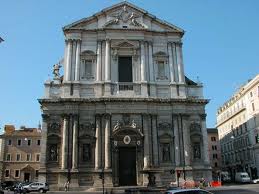
The bus now skirts round the corner of the Teatro Valle. The 'Valley' in question was where in ancient times, Agrippa (the Emperor Augustus's most trusted general, right-hand man, son-in-law and intended successor - except he died before Augustus!) had laid out a set of public buildings, including some nearby Baths (over to the right as you continue up the street) and a big lake, the 'Stagnum' (over which you are currently travelling!) This whole area was a sort of public park covered with grand colonnades and temples.
You now bear right into the Piazza di Sant'Eustachio. The church itself (opposite to the left) is pleasant enough if a little dark; but what draws the world to this piazza is the café on your right, rather kitschly illuminated with blue neon tube lighting. When people talk of 'Eustachio' they are usually referring to the café rather than the church…arguments abound over whether this place serves the best coffee in Rome, or whether that's a place called the 'Tazza d'Oro' beside the Pantheon. Try them both and make up your own mind! I know which one gets my vote…and you've just passed it.
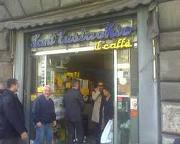
Behind you as you leave the piazza, although you're unlikely to see it from the bus, is Borromini's refreshingly plain (apart from its famous 'bee-sting' campanile for the Barberini family) church of Sant' Ivo. Come back on a Sunday morning if you want to get in.
From here, the bus zig-zags along behind the Pantheon - which needs a whole page of description to itself, and I'm not even going to start here. Sadly you can only glimpse the back of it as you emerge from Via di S. Chiara into the Piazza della Minerva, with Bernini's famous Elephant Obelisk (see'The Obelisk Trail') in front of the church of S. Maria sopra Minerva to your left.
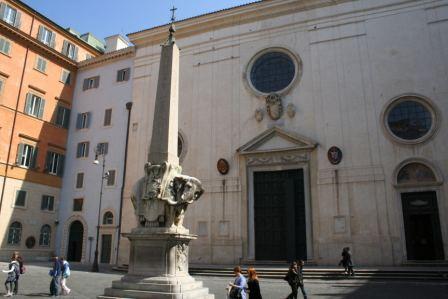
Unusually for Rome, the interior of this church is in the Gothic style (not the original design however). It gets its name from the belief that it was built over an ancient temple to the Roman goddess Minerva, although it is actually closer to one dedicated to the Egyptian cult of Isis - an appropriate place for an Obelisk (for once!) Amongst many interesting works of art inside is the tomb of the great artist Fra Angelico, and a wonderful statue by Michelangelo of Christ carrying the Cross - much less-well known than many of his statues, but as good as any. Both Medici Popes (Leo X and Clement VII) are also buried here, and the church had strong ties with the family's native Florence.
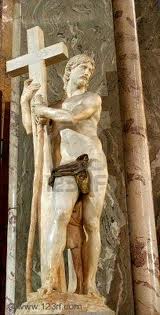
If you don't get snarled up for good in traffic at this point, you will snake along first Via di S Caterina di Siena, and then the Via del Pie' di Marmo. The 'marble foot' in question can be glimpsed on your right at the junction with Via di S. Stefano di Cacco. Likely to have been once part of a statue associated with the Temple of Isis, it's one of those typical Roman oddities - just "there", probably with a moped chained up to it.
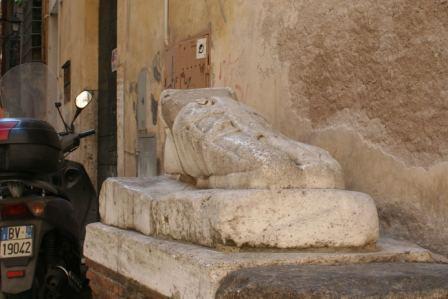
Next, you emerge into Piazza del Collegio Romano, taking the right-hand side around the parked cars. Originally much grander, the Collegio (on your left) is now simply a state high-school. Far more interesting is the massive palace taking up most of the top right corner of the square. This is the Palazzo Doria-Pamphilj, still the main residence of the current prince of these conjoined ancient families. A few of his state-rooms and his splendid patrician picture gallery can be (ought to be!) visited - the main entrance is actually on the Via del Corso at the front (beware of taxi-drivers who still think it's here in the piazza!); the prince himself gives a fascinating and surprisingly quite personal commentary via a guide-phone. Amongst the unmissable works of art are two depictions of the Pamphilj Pope (the ending 'j' isn't a typing error - it's just a rather 'affected' old-fashioned spelling in place of the 'i' which is how it is really pronounced!) Innocent X. The more flattering of the two is a bust by Bernini; the other is a remarkable portrait - revealing rather more about how he failed to live up to his name - by Velazquez.
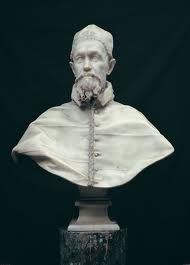
You should get a glimpse of the Via del Corso to your right (at the end of Via Lata) as the bus swings out at the left corner of the piazza, travels along the side of the Collegio, and continues its zig-zag into one of Rome's most attractive small squares, the Piazza di Sant'Ignazio. This is named for the church you are passing on your left. St Ignatius of Loyola was the founder of the Jesuits, and his church is certainly decorated in a style befitting its dedication. One highlight is the 'trompe l'oeil' cupola by Pozzo: the trick of perspective makes you think it is truly 3-dimensional, when in fact it's just a flat painting.
You may however decide you prefer the design of the Piazza outside (look right). It is created almost like a stage-set with separate back-drop and wings, attractively painted in subdued pink and orange. The inspired architect was Filippo Raguzzini, who had it built in 1728. The restaurant on the right is not a bad place to sit on a summer evening as dusk falls and the bats begin to fly around the piazza.
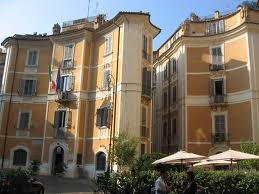
The bus leaves the piazza at the far right end (diagonally from where you came in) along Via de' Burro, which heads over in the direction of the Corso again; then however it twists left, and you cross the right-hand side of the Piazza di Pietra ("Stone Square"). Crane round behind to your left and you will see the stones that give the square its name: the massive marble columns which are the remains of the Temple of Hadrian - another of Rome's hidden treasures. The building of which they form one side used to be Rome's Stock Exchange (the 'Borsa') before these financial dealings were moved up to Milan. A further examination on foot will reveal how far below modern ground-level the bases of the columns really are - you can see right down to the original ancient street about 5 or 6 metres below.
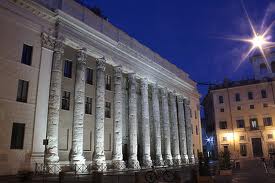
(WARNING - this next section is seriously out-of-date!)
Actually, as the bus carries on along Via dei Bergamaschi, if you have jumped ship temporarily you can have a drink or a snack at the bar at the end on the left of this street: Bar 'Chigi' (now closed!) gives you a foretaste of what lies just ahead. As you will see, the bus comes out into the Piazza Colonna, dominated by Rome's 'other' column. It is true that the carving spiralling around this one, dedicated to Marcus Aurelius (emperor-but-one after Hadrian) is inferior to that of the much more famous Trajan's Column near the Forum, but it still seems rather unfair that most visitors to Rome are unaware it even exists.
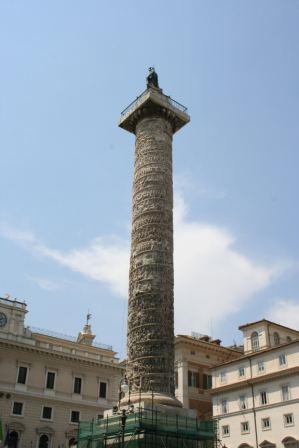
(Again, the paragraph below no longer holds true... much more security nowadays!)
More amazingly, though, on the far side of this square is the official residence of Italy's Prime Minister, in Palazzo Chigi (the 'Chigi' were yet another of the old Roman patrician families). What a difference from our own Number 10! Most days in the piazza, you will only see about one lone police car (with its occupants probably posing by the fountain, or chatting up a signorina or two). When Silvio was the PM he had two pads in the vicinity: his main palace is still just around the corner at Palazzo Grazioli; now he has gone, whoever is the Prime Minister this week has the honour of using these offices now, and it is quite surprising that you can walk practically right up to the front door here and knock on the windows... can't imagine that happening in Downing Street! Bar Chigi across the square is practically the PM's local - and still not too far for Silvio to come for old time's sake...sadly you are unlikely to bump into him (he has one or two things on his mind at the moment)… but you could have a quick one there yourself anyway!
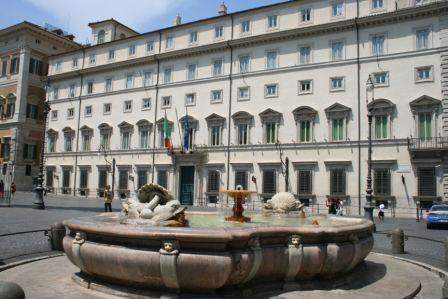
Many of the other government buildings are close by here; the Chamber of Deputies meets just one block behind in Piazza di Montecitorio. The other impressive palace (Palazzo Wedekind) behind the column is the head office of one of Italy's main daily newspapers, 'Il Tempo'.
At this point, strictly speaking, we leave the Campus Martius. The bus turns left onto Via del Corso (always just called 'Il Corso'),the deceptively long (when you try walking it…) and straight road that runs North from central Rome more or less along the line of the ancient Flaminian Way. In those times it was known as Via Lata ("Broad Street") - a little confusingly now as there is a narrow street by that name branching off sideways, which we have actually just passed. It gained its current name (which simply means "The Race-course") from the spectacular riderless horse races which were run along it from medieval times until the nineteenth century. It is one of Rome's most lively main thoroughfares today, having very different 'characters' along its various stretches, with the top end being particularly attractive, not least because it is mostly pedestrianised.
We are not going to be on it for long today, however; but before the bus turns right, there should just be time to have a look at the modern shopping arcade known as Galleria Colonna (not to be confused with the great patrician art collection of the same name!) to your right. Strictly speaking, its 'proper' name is Galleria Alberto Sordi (re-dedicated to the very popular character actor and director who died in 2003) but locals tend to refer to it by its original name almost interchangeably. Its air-conditioned Y-shaped mall can be a welcome retreat for a pitstop on a hot afternoon. You may also notice signs advertising an underground book-store (we drive over it as the bus turns),appropriately named 'Libreria di M Tullio Cicerone' after the great Republican orator, politician and book collector Cicero!
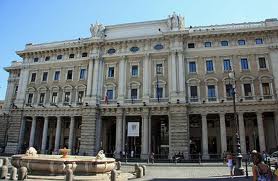
In the unlikely event that you have so far had the bus to yourself (or at least a seat to sit on with reasonable leg-space) I'm afraid all that is about to change, as the bus makes a central stop at the bottom end of Via del Tritone (here known as Largo Chigi). There are usually a lot of people just waiting for any bus that will save them a boring walk uphill on this rather dull and unremarkable street. There are plenty of attractions off at each side - this is as close as you'll get on this trip to the Trevi Fountain - but very little to detain you until the bus reaches the large traffic-island at the top that is known as Piazza Barberini, and see the reason for the street's name.
Standing a little solitary at the near edge of the piazza is one of Bernini's masterpieces, the Fontana del Tritone - Triton Fountain. This was carved to represent the sea-deity whose name it bears, blowing a tall jet of water from a conch as he sits atop a scallop-shell supported by dolphins. Even if for some reason today the jet is no longer so high, it is still a very successful creation honestly deserving a far better setting than this - how the square has evolved over the intervening years into such a noisy traffic-ridden hub can be seen from photos of earlier days.
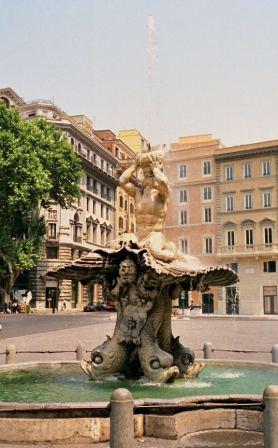
The bus travels around the right side of the piazza, and enters one of the most famous streets in post-war Rome, the Via Vittorio Veneto - not named after a person, but to commemorate a victory in battle. From here it begins an S-shaped climb up towards the North of the city. At the bottom on the right is a second Bernini fountain: the Fontana dei Api - Fountain of the Bees. This is again shaped as a scallop-shell, standing on its edge like a fan above a small basin where several stone bees are enjoying sipping at the water (they were the emblem of the Barberini family, whose Pope Urban VIII commissioned both this and the Triton; the whole piazza stands above what was once his underground family stables!).
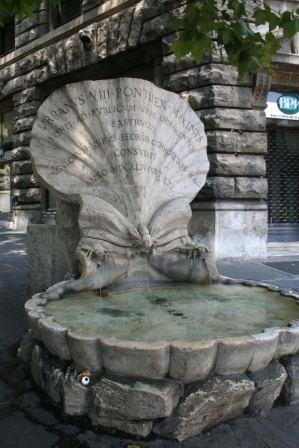
Via Veneto (to give it its more usual name) became the symbol heartland of Rome's 'Dolce Vita' society-life in the 1950's. It was the haunt of celebrities, especially the film-stars of the Cinecitta studios, and of course the attendant people-spotters and paparazzi who were there to glimpse them. These days, sadly, it is reduced to living off its reputation: a bit too full of tourists and business-men paying far too much at a restaurant hoping to see or be seen themselves.
Just a little way up from the Bee Fountain, still on the right, stands the Capuchin Monks' church of S. Maria della Concezione. This has become a favourite stop on the 'Weird Things in Rome' tour. It contains some fairly macabre carvings and tombs inside the church itself (in particular that of Urban's elder brother Antonio Barberini, the church's founder - and evidently a rather more ascetic character than most of the rest of his family - "here lies dust, ashes, nothing…"); but also, even more startling, is the crypt, where the bleached bones and skulls of hundreds of faithful monks (and, mysteriously, not a few children) are laid out in extraordinary patterns and tableaux, for reasons, as far as I know, unexplained - apart from the squeamish delight of donating tourists. You have to see it to believe it. No really, you do just have to…!
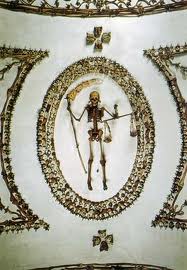
The only other interesting sight as the bus continues to labour up the street is again on the right, about half-way up: the Palazzo Margherita, set back from the road in some attractive gardens behind a well-guarded gate and fencing. This is currently the US Embassy. I will resist the temptation to make pizza-jokes.
At the top of the street, the bus passes under the vast bulk of the Porta Pinciana, one of the original gates in the encircling wall built by the emperor Aurelian in the fourth century, who was by now rather more fearful of attacks from barbarians than his predecessors had needed to be.
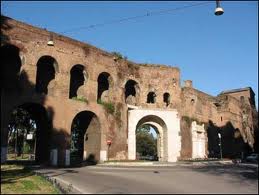
For a couple of minutes you are in deep traffic, joining the main Corso d'Italia at some traffic lights, before branching away to the right near an entrance to one of Rome's loveliest public parks, the Villa Borghese. The first bus-stop around the corner is at a walkway leading through the park towards the superb Galleria Borghese, and hopefully some of your fellow-passengers will get off to walk there; what they don't know is that the bus travels on through the park, and ends up much closer, saving time and effort. That stop ahead is the furthest the bus goes - but not actually its terminus at this end!
Meanwhile the bus carries on through the outer part of the Villa Borghese gardens along Viale San Paolo di Brasile. The gardens were laid out for this famous family, around the 'house' that is now the Galleria, over the course of several centuries (beginning in the 1700's) as they became altered or expanded according to the influence of its various owners. It was finally handed over to the public in the early 1900's. Contained within its 6 kilometre circumference is a beautiful variety of trees, fountains, wild and landscaped areas, a small boating lake in front of a reproduction 'Temple to Aesculapius', a mini 'Shakespeare's Globe' theatre, and even a zoo! Native Romans love it as much as visitors do, and at weekends you can often find families out together trying out the pedallo-carriages, cycling, walking their dogs or just relaxing under the shade of the umbrella pines.
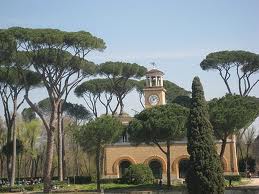
Turning right at a small roundabout (in the Piazzale delle Canestre),the bus enters the park proper. The path opposite behind leads to the Pincio gardens, reaching eventually the panoramic terrace that looks out over the Piazza del Popolo with a view stretching ahead towards St Peter's - it's a glorious spot, especially at sunset. Travelling on, however, the bus is now in a completely different world from its noisy climb up Via Veneto and the snarl-up under the Porta Pinciana. You may just glimpse the 'Temple of Aesculapius' on the left at the end of a path through the trees; and as the bus turns right you travel around two sides of the so-called Piazza di Siena, laid out like a mini grass stadium with rows of 'spectators' seats'.
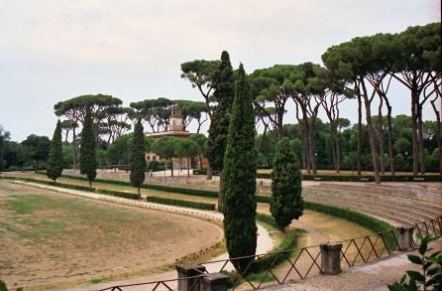
This takes you onto Viale dei Cavalli Marini - "Sea-horse Avenue". Halfway along you will pass the charming fountain which gives the road its name. It's one of Rome's loveliest, and also one of the least well-known.
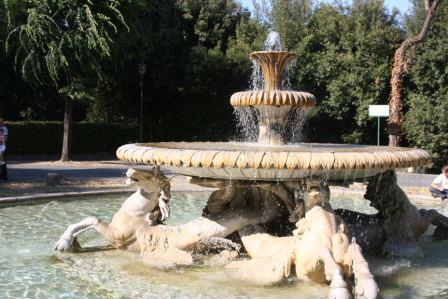
Reaching the end of the avenue, the bus turns in a complete circle and stops, before returning the way it came through the park. Here's the spot to get off for the Galleria Borghese, just a short walk up to your left (as you approached).
If I had to recommend just one gallery to visit in Rome (impossible task!),it would have to be this one: it contains so many really top-class works of art, especially some of Bernini's most famous sculptures, and paintings by Titian and Caravaggio. Almost as beautiful are the rooms in which they are displayed! It also has the advantage of being relatively small, so there is no danger of aesthetic exhaustion… Unlike most museums in the city, however, you do need to make a booking in advance (there is limited entry at 2-hour intervals). The simplest way to do this is to jump ship from the bus at this point, walk up, and book your slot for a return visit on a later day; you can also take advantage of the small café in the book-stall area - no booking needed for this (although be warned - a friend currently living in the city reminds me that to visit the loo there you will need to be able to show a valid booking-ticket...)!
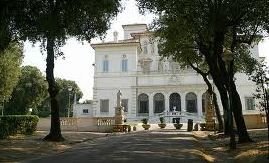
While you are waiting for the next bus to take you back through the gardens, you could also seek out another nearby shady fountain, just under the trees off the corner between Sea-horse Avenue and the Museum Road. A more peaceful and idyllic spot would be hard to imagine than this, as you sit on the circle of marble 'benches' listening to the gentle drip of the fountain and the cawing of the resident colony of hooded crows.
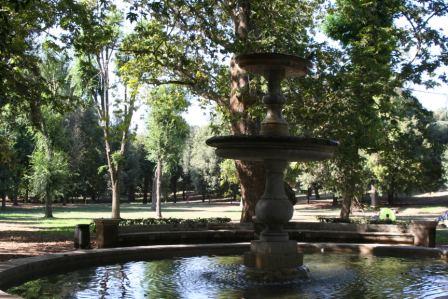
If you have taken time-out here, rejoin the next bus and enjoy passing back through the Borghese gardens the same way that you came. At the last exit, crossing the Corso d'Italia once more, you pass under another arch of the Porta Pinciana and bear right onto the Via of the same name. Just a score of metres down this road, the bus pulls in and stops. It's the end of the line!
If you want to continue back towards the city-centre, or do the North-South route, transfer onto whichever of the waiting buses looks as if it will leave first - or choose the one after, to make sure you get a seat! Another way to return to central Rome is to walk up to the top of the street and go down into the Metro station subway at the top of Via Veneto. Which Metro station is it? In fact, it connects - via a hugely long underpass, with exits to one of the city's main underground car-parks, airport-style moving pavements (which sometimes actually work…),a couple of bars, and even a supermarket - to the Spagna Metro station next to the Spanish Steps - a useful short-cut to know, even if you don't want to take a train!
On this ride you have taken a trip through some very different regions of the city: quiet medieval streets, lively tourist haunts, the heart of Italy's government, erstwhile 50's chic and wonderful shady parks. But equally, it has been a journey through time, taking in the designs and treasures of artists and architects across the centuries. I hope it has shown you just what a wealth of variety there is to be found in Rome - it's what helps to make it such a special place: somewhere you can never finish exploring however many times you visit. There really is no place like…Rome!
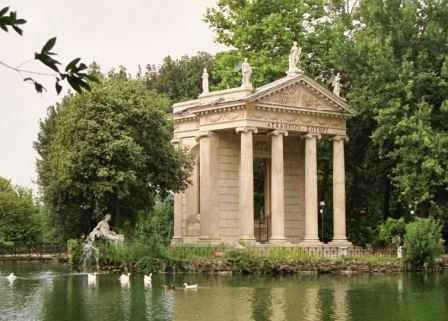
Back to top

